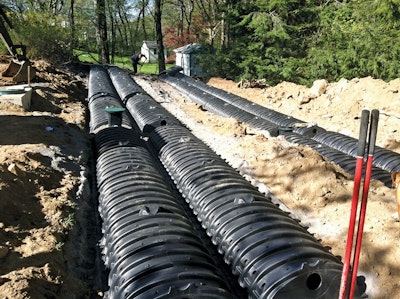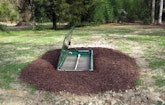Interested in Drainfield Media?
Get Drainfield Media articles, news and videos right in your inbox! Sign up now.
Drainfield Media + Get AlertsGravel filter and drip irrigation package keeps owner in home
Problem: A homeowner located in Noblesville, Ind., was dealing with a failed lateral field on a typical septic gravity system. Surfacing sewage was becoming a health concern for the resident and his neighbors. The Hamilton County Health Department determined a secondary treatment system with a new location for the effluent disposal area was needed.
Solution: A 450-gpd recirculating gravel filter combined with a timed-dose drip irrigation disposal package from Clarus Environmental was installed by a local contractor. The recirculating gravel filter has the treatment capability of less than 10 mg/L BOD5 and less than 10 mg/L TSS. Utilizing turbine effluent pumps made it possible to redirect the treated effluent to the drip irrigation disposal area. The total package included a control panel, effluent pumps, effluent filter, gravel filter with components and drip irrigation.
Result: The Hamilton County Health Department approved the secondary treatment system and the resident maintained occupancy. 800/928-7867; www.clarusenvironmental.com.
Biofilter peat system solves septic clogging issue
Problem: An existing drainfield on a single residential property located in Bucks County, Pa., was malfunctioning to the ground. Biomass had clogged the septic system and wastewater backed up into the soil over the drainfield and surrounding area. Lot topography, restrictive site soils, a high water table and shallow limiting zone did not allow for a conventional or alternate septic system to be installed. The only available area was slightly off contour and next to an existing swale.
Solution: Rob Bowie, a soil scientist from Bux-Mont Home Inspection Services in Doylestown, tested the area and permitted an experimental septic system as the only suitable solution. The septic system selected was the Ecoflo Biofilter peat system from Premier Tech Aqua for effluent infiltration with a DiUV self-cleaning ultraviolet radiation unit for disinfection light. The station produces a quality effluent of less than 10 BOD mg/L, 10 TSS mg/L and 200 cfu/100 mL fecal coliform, which is then pumped into a conventional sand mound for final treatment and dissipation.
Result: The Pennsylvania Department of Environmental Protection and the Bucks County Health Department approved the wastewater treatment solution, which eliminated a health concern and ongoing surface malfunction. Installation work was performed by Mullenax Excavating in Ottsville, Pa. 800/632-6356; www.premiertechaqua.com.
ATU provides solution for home with failed drainfield
Problem: Homeowners outside Chapel Hill, N.C., had a conventional septic system with a drainfield dispersing into poor soils. When the drainfield failed, the lot was too small to put in a new one, and sewer service wasn’t available. Facing the possible loss of their home, the homeowners needed a solution to meet both their space constraints and permit limits of less than 30 mg/L BOD5/TSS, as well as less than 200 cfu/100 mL fecal coliform.
Solution: Engineer Kevin Davidson suggested installing an AdvanTex AX20-RTUV advanced wastewater treatment system from Orenco Systems. Featuring UV disinfection, it eliminates the need for a discharge tank and separate UV basin, and produces effluent that meets the state’s surface discharge standards, making the drainfield unnecessary. The North Carolina Division of Water Quality approved the repair and the system was installed as designed, with disinfected effluent discharging to a ditch.
Result: Operation is well within permit limits, with effluent quality of 5.8 mg/L BOD5, 4.1 mg/L TSS, and 72 cfu/100 mL fecal coliform. This was the first North Carolina installation of this particular system for surface discharge. 800/348-9843; www.orenco.com.
Bush camps require transportable systems
Problem: Northern Ontario, Canada, is booming with remote mining exploration and forestry “fly-camps,” many with running water, but most with only rock and muskeg swamp and no free-draining soil. Importing sand or soil to treat sewage is expensive, often impossible, and when the camp moves on, this contaminated component was being left behind. The Ontario Ministry of Environment stipulated camps needed a lightweight, reuseable system with a permanent filtration medium that could be moved from camp to camp by light truck or helicopter.
Solution: After discussions with Canadian Shield Consultants, the Ministry of Environment approved a new design by Waterloo Biofilter Systems and fabricated by D & L Products that met the removable/transportable criteria and minimized pollution in the wetlands. For surface discharge, 10 mg/L CBOD and TSS is required, clear enough to be disinfected by ultraviolet radiation. Using an absorbent foam medium, a biofilter tower is made by stacking individual flat cylindrical segments in a series, the height depending on the flow.
Result: The segments are easily transportable and assembled, even rolled along by hand. They can be installed with the septic tank inside a transport trailer. When used outside, they are disassembled and reused in another stack made at the next site. The absorbent foam filtration medium is contained within the segments and nothing is left on site except treated effluent. The Ministry of Environment reports no issues with the systems in use. 519/856-0757; www.waterloo-biofilter.com.
New onsite system keeps septage leeching in check
Problem: A 300-gallon steel septic tank located at a private, single-family residence in Prospect, Conn., collapsed unexpectedly in the winter of 2012. Not only was this a serious safety issue, but also a major health issue. Upon further investigation, it was found that the septic tank was not up to code in terms of its distance from the well, and septage was actually leaching into the family’s yard instead of the drainage fields.
Solution: A contractor from Green Construction Management LLC, worked with the Chesprocott Health District to design and install a new, up-to-code septic system. A large crane was brought in to move the tank to the required distance of 75 feet from the well. In addition CULTEC’s plastic Contactor(r) 100 chambers were installed in place of concrete galleries or a conventional pipe and stone system. These chambers maximize contact area by using fully open bottoms and perforated sidewalls.
Result: The new septic system meets all of the codes set forth by the Chesprocott Health District and works efficiently and effectively. 800/428-5832; www.cultec.com.









